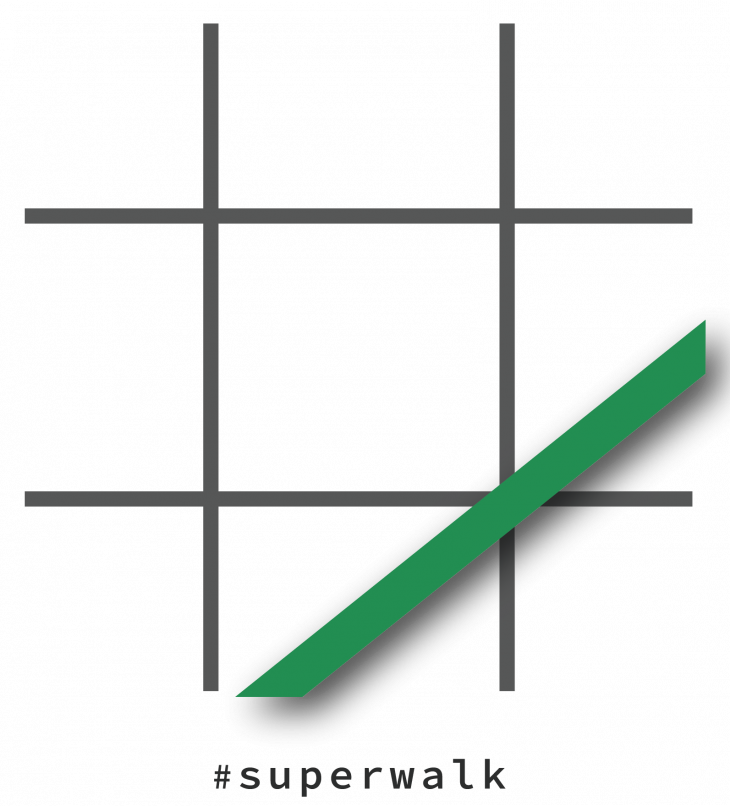 Barcelona should no longer be dominated by cars. Most of the streets have been turned into pedestrian-friendly public spaces. SUPERBLOCKS: four to nine neighboring residential areas connected by diverting the flow of cars. If the plan is fully implemented, Barcelona could become a place where the pedestrian user is more appreciated than the CO2 emitting users.
Barcelona should no longer be dominated by cars. Most of the streets have been turned into pedestrian-friendly public spaces. SUPERBLOCKS: four to nine neighboring residential areas connected by diverting the flow of cars. If the plan is fully implemented, Barcelona could become a place where the pedestrian user is more appreciated than the CO2 emitting users.
“The main goal is to build cities. A city starts to be a city if it has public spaces.”
Salvador Rueda (director of the Urban Ecology Agency of Barcelona)
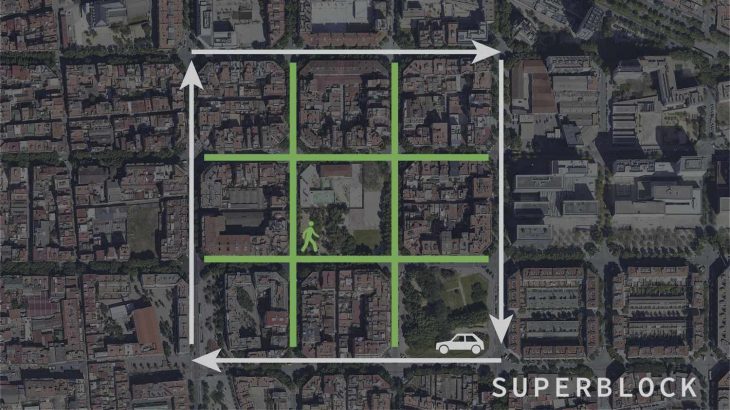 Barcelona should no longer be dominated by cars. Most of the streets have been turned into pedestrian-friendly public spaces. SUPERBLOCKS: four to nine neighboring residential areas connected by diverting the flow of cars. If the plan is fully implemented, Barcelona could become a place where the pedestrian user is more appreciated than the CO2 emitting users.
Barcelona should no longer be dominated by cars. Most of the streets have been turned into pedestrian-friendly public spaces. SUPERBLOCKS: four to nine neighboring residential areas connected by diverting the flow of cars. If the plan is fully implemented, Barcelona could become a place where the pedestrian user is more appreciated than the CO2 emitting users.
“The main goal is to build cities. A city starts to be a city if it has public spaces.”
Salvador Rueda (director of the Urban Ecology Agency of Barcelona) SUPERWALK is an approach to achieve Barcelona’s vision of reducing the dominance of cars by creating a new kind of public space. It is an instrument that helps the city characterize pedestrian-friendly public spaces. The character of the Superwalk is an elongated walk for the uninterrupted flow of pedestrians. The vision of urbanism in the 21st century that pushes the car back and restores citizens’ sense of community.
SUPERWALK is an approach to achieve Barcelona’s vision of reducing the dominance of cars by creating a new kind of public space. It is an instrument that helps the city characterize pedestrian-friendly public spaces. The character of the Superwalk is an elongated walk for the uninterrupted flow of pedestrians. The vision of urbanism in the 21st century that pushes the car back and restores citizens’ sense of community.
from Pedestrian Street …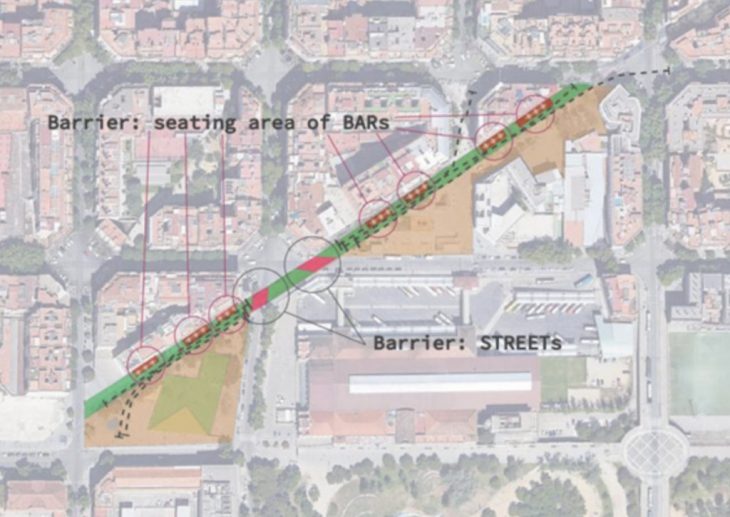 The current pedestrian street connects the city node with a residential area and a public space area alongside it, through a line that cuts the typical house block system of Barcelona. People reach their destinations without passing the streets between the blocks. There exists a high frequency of people during the day, but two streets are interrupting the flow of people and tables from Bars and Restaurants are limiting the broadness of the street.
The current pedestrian street connects the city node with a residential area and a public space area alongside it, through a line that cuts the typical house block system of Barcelona. People reach their destinations without passing the streets between the blocks. There exists a high frequency of people during the day, but two streets are interrupting the flow of people and tables from Bars and Restaurants are limiting the broadness of the street.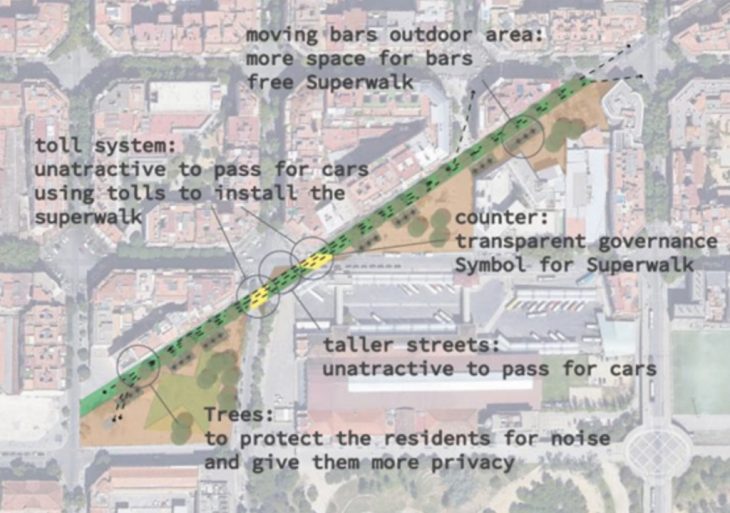 … to the Superwalk
… to the Superwalk
- Revamping the trees and foliage above the walk could improve the noise barrier between the pedestrian and the resident above, and at the same time give more privacy to the residents.
- Elevated road at the intersection makes it less attractive for cars to pass through.
- A real-time counter to show the accumulated toll is installed on the ground to give the Superwalk a symbol and will be recognized by locals and tourists, and at the same time shows the progress for the public space development.
- To create more space for the flow of people tables and chairs of bars and restaurants are moved to the park where they have more space and a calmer atmosphere
THE INTERFACE
The main technology used in Superwalk to capture data on the intersection:
- Automatic number-plate recognition
- Central repository/cloud database
- Real-time car counter with sensors
The funds sponsoring the public spaces within the Superwalk will be generated from the Toll system. In this way, the site will become self-sustaining ‘auto-rejuvenating’ public space. When the public space project is accomplished, the toll system will end.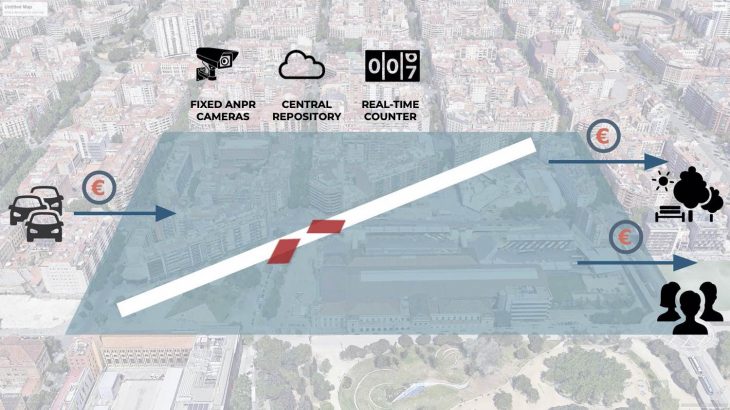 Toll System
Toll System
- Time-limited (System ends until public infrastructure project is fully funded)
- Transparency in funding a public space
- Real-time counter (an indicator of Superwalk existence)
- Uses cameras to detect license plates and sends a bill at the end of each month to the address associated with the passing car. This is an existing method used around the world.
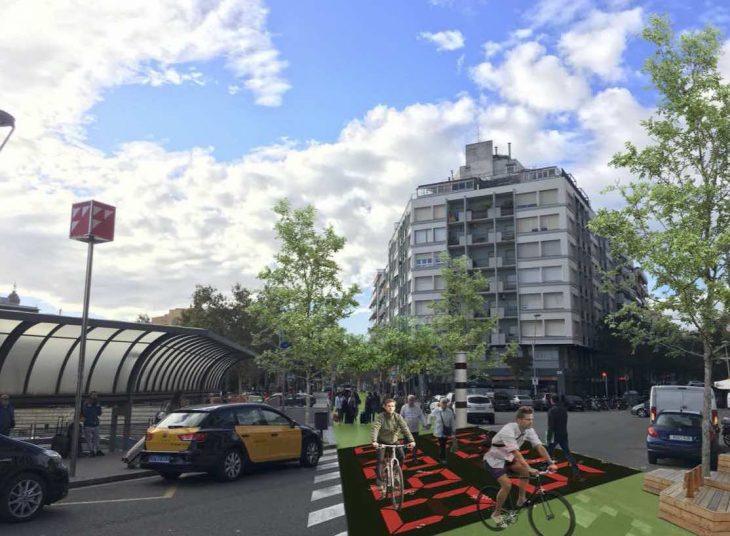 The conditions for our superwalk are not unique to Barcelona
The conditions for our superwalk are not unique to Barcelona
- Superwalk would work in any location where a public space is shared by multiple users. Preferably one where CO2 emitting users are intruding on a space used by non CO2 users.
- Amsterdam- bicycle paths intersecting with streets.
- Tokyo – a pedestrian walkway intersects a street
- Cambridge – a street cuts through Harvard Campus, interrupting the flow of students.
Superwalk is a project of IaaC, Institute for Advanced Architecture of Catalonia
developed at Master in City & Technology in (2019/2020) by:
Students: Jochen Morandell, Eli Munn, Aryo Dhaneswara
Faculties: Nicolay Boyadjiev